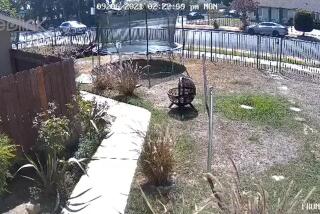In High-Stakes Trials, Computer Graphics Simplify Complex Cases
PALO ALTO — Computer animation on a video screen gave jurors a pilot’s view of the frightening moments just before a DC-10 crash during the recent trial pitting World Airways against the Massachusetts Port Authority.
It was the latest in a growing trend by cities and companies to use computer graphics to simplify complex, high-stakes cases for jurors.
The computer can re-create events as witnesses claimed they happened, or change events as they might have occurred under different circumstances.
It can allow jurors to look inside building designs in three-dimensional drawings on a video monitor or projection screen to see whether construction was faulty. Details of car or plane crashes can be re-enacted. Accidents can be sped up or slowed down.
“In the old days, judges occasionally would bar re-enactments,” Stanford University law Prof. John Kaplan said. “But increasingly judges are more willing to allow this type of evidence, including computer animation. The general rule of law is (that) attorneys can use any kind of evidence of this kind if it purports to clarify the facts accurately.”
In the World Airways case, the Oakland-based airline sued Massport for $75 million, claiming that it failed to inspect and maintain the Logan International Airport runway before the Jan. 23, 1982, crash that killed two people and destroyed the plane. Massport claimed that pilot error contributed to the crash.
Massport’s attorneys hired an engineering company, Failure Analysis Associates of Palo Alto, to analyze the accident and produce a computer animation showing the pilot’s cockpit view. The three-minute, 15-second tape showed the plane’s descent from an altitude of 1,800 feet.
“I think it was a very important and valuable piece of evidence,” Massport attorney Robert Brintz said. “Computer animation is an outstanding tool for the courtroom.”
World’s attorney, Jim Meehan, objected to the video evidence because he believed that it would mislead the jury. He was overruled.
“I disagreed with what it depicted,” Meehan said. “People today have a tendency to believe what they see on a video screen. There’s no doubt that video graphics are very effective. I’ve used them myself.”
In this situation, it was hard to determine how effective the show was since the judge declared a mistrial when the jury couldn’t reach a verdict.
However, attorneys and the companies that produce computer graphics remain enthusiastic.
“The computer is like H. G. Wells’ time machine,” said Roger L. McCarthy, president of Failure Analysis. “For the first time now, we can take people back in time and re-create events so they can make their own judgment. The power of that compared to the one- or two-dimensional (presentation) is unsurpassed.”
Failure Analysis is a $25-million-a-year company with a staff of scientists who have analyzed more than 7,000 accidents, from the cracking of three giant natural gas storage tanks in Abu Dhabi to the recent crash of an airplane at a shopping mall in Concord, Calif.
“The level of scientists we have on the staff is capable of doing an analysis far more sophisticated than the average person could easily grasp or have easily explained,” McCarthy said. “About half of our work involves some sort of litigation.”
Pioneered Use
Graphic Evidence of Los Angeles helped pioneer computer graphics for the courtroom about eight years ago, and last year had gross revenues of $750,000, company president Robert Seltzer said.
“At first it was being used in a very limited way,” said Seltzer, a former law student who began his company to pay bills. “Today, big and small trials across the nation are using various types of demonstrative graphics. It’s reached a point where most attorneys would say you need to walk into the courtroom with some kind of show and tell.”
Seltzer and Garrison Kost, who runs the graphics department at Failure Analysis, have been promoting the service to attorneys.
“A year ago, we were just scratching. Now we’re getting more than 20 inquiries a month,” Kost said.
The problem for attorneys faced with computer animation is how to attack it.
Can’t Cross-Examine
“You don’t cross-examine the computer. You cross-examine the data and the person who put it in,” said Harold Caplener, a San Jose attorney. “If you don’t know how to attack that kind of evidence, it’s going to come in and you’re dead.”
Graphic Evidence’s scriptwriters work with engineers, lawyers and doctors--often by committee--to produce animations or slide shows to show a jury.
Cost depends on the complexity, the technical detail and length, and the time it takes to generate, McCarthy of Failure Analysis said.
“Typically, we can generate a very nice three-to-five-minute tape for about $5,000,” he said. “They’ll be basically line figures, but clearly discernible. You can get up to six figures if you want beautifully rendered, shaded images and 10 to 20 minutes of computer-animated images.”
He said it is not uncommon to spend $100,000 or even several hundred thousand dollars to do the complex stress analyses in some accidents.
“So for a few thousand dollars more, you can have beautiful graphics out of it,” McCarthy said.






